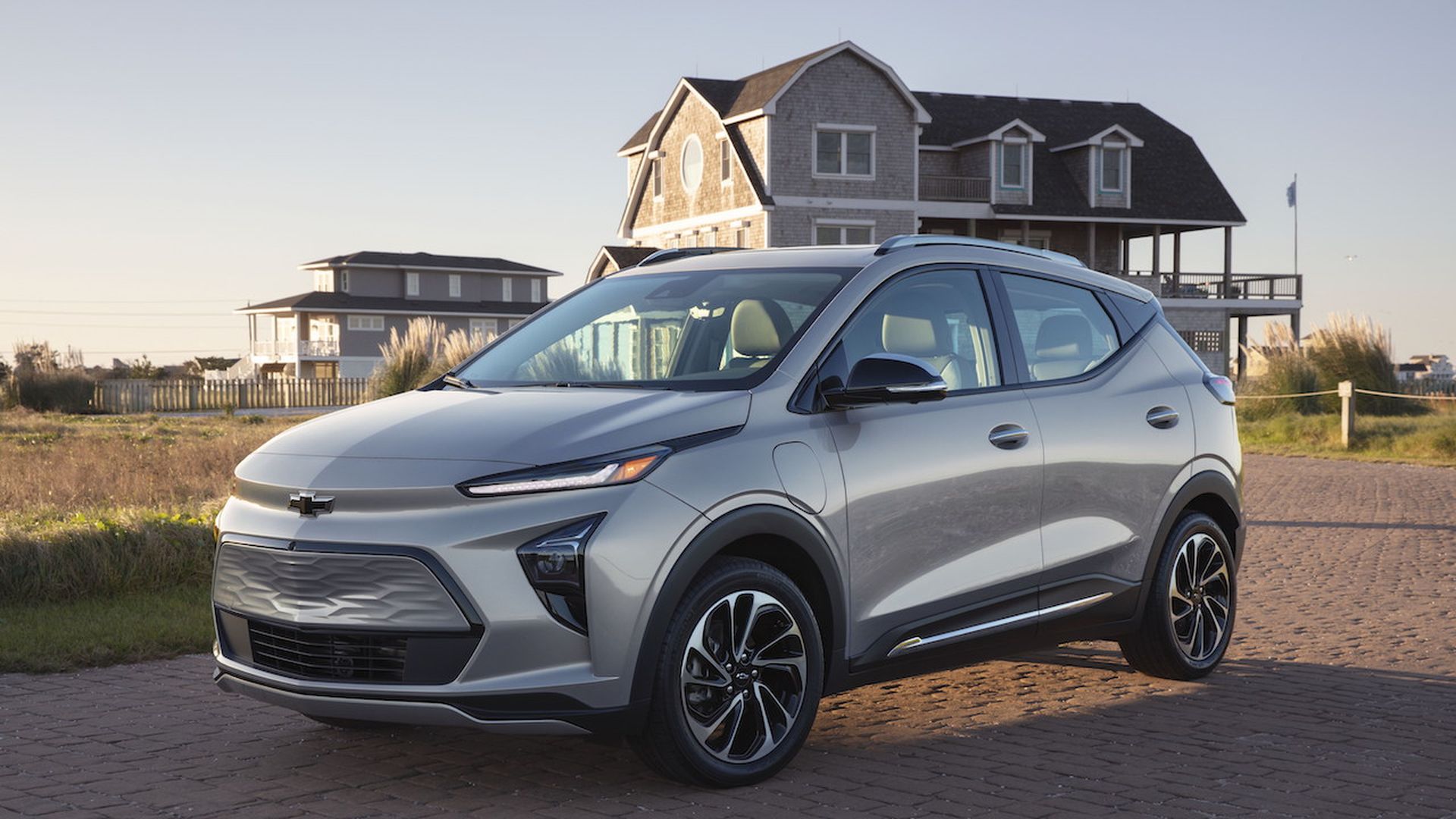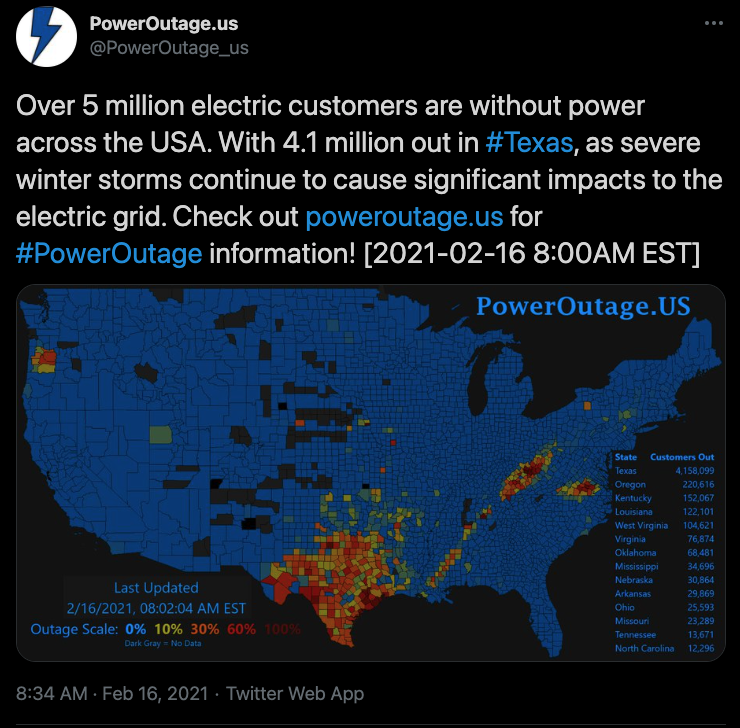| | | | | | | Presented By ExxonMobil | | | | Generate | | By Ben Geman ·Feb 16, 2021 | | Welcome back! Today's Smart Brevity count is 1,319 words, 5 minutes. 🎶 And The Fugees' classic album "The Score" turned 25 over the weekend, so that pioneering act has today's intro tune... | | | | | | 1 big thing: Oil majors stake geothermal startup |  | | | Illustration: Sarah Grillo/Axios | | | | The VC arms of Chevron and BP are funding Eavor, a startup looking to commercialize a form of geothermal energy that it says can provide large-scale power in many regions worldwide. Why it matters: It's the latest sign of momentum and investor interest behind technology that could significantly scale up geothermal. - It's a very old power and heat source that remains very niche compared to the immense theoretical potential of tapping high subsurface temperatures.
The big picture: The participation of Chevron and BP shows how oil giants are diversifying into clean energy — and in this case, a form of geothermal that borrows the industry's drilling and geological know-how. Driving the news: Calgary-based Eavor this morning announced a $40 million funding round. - Other backers are investment firms Temasek, BDC Capital, and Vickers Venture Partners, and Eversource.
- "These investments, and the partnerships formed around them, are critical to the commercialization of the technology and to help Eavor scale its already extensive project pipeline," the announcement states.
- The company's development pipeline includes planned or potential potential projects in Europe, Canada and elsewhere.
- The amounts coming from the different funders was not disclosed and Eavor declined to offer a breakdown.
How it works: Geothermal energy can come from multiple ways of accessing high-temperature underground aquifers and rock formations. Eavor's effort aims to commercialize a "closed loop" system in which deep wells are connected underground with lateral connections. - In the "closed" system, fluids are circulated through the system and heated by high underground temperatures, forming what they call a "massive subsurface radiator."
- The process is meant to operate without energy-consuming pumps — instead relying on the natural effect of hot fluid rising and cool fluid falling.
- The thermal energy brought to the surface can be used for direct heating or converted to power.
- The method could provide both baseload power and act as a dispatchable battery to complement wind and solar, the company said.
Yes, but: "To grow as a national solution, geothermal must overcome significant technical and non-technical barriers in order to reduce cost and risk," noted a major 2019 Energy Department analysis (h/t Yale Environment 360). - That DOE report, however, sees tech, cost and regulatory improvements providing the potential for geothermal to grow 26-fold to provide 60 gigawatts of power capacity in the U.S. by 2050.
The intrigue: The emerging forms of geothermal involve tricky and deep subsurface technologies. - They rely in part on the same kind of drilling advances used in the oil-and-gas sector — including use of lateral well tech.
- That's not lost on the oilfield services industry, with companies including Baker Hughes and Schlumberger seeing growth potential.
Go deeper: Geothermal energy is poised for a big breakout (Vox) |     | | | | | | 2. The status and politics of the Texas power crisis | Screenshot of Twitter feed for poweroutage.us More than 4.3 million Texas homes and businesses are without power as of this morning, per the tracking service poweroutage.us. Why it matters: Bitter cold temperatures and winter storms are wreaking havoc on the power system in Texas and its refineries, and affecting other states too. The big picture: Via The Houston Chronicle... - "The Texas power grid, powered largely by wind and natural gas, is relatively well equipped to handle the state's hot and humid summers when demand for power soars."
- "But unlike blistering summers, the severe winter weather delivered a crippling blow to power production, cutting supplies as the falling temperatures increased demand."
What we're watching: FERC chairman Richard Glick said in a statement that they would be "examining the root causes of these reliability events," but the current focus is on power restoration and safety. The intrigue: We'll also be looking to see how the outages in Texas affect the politics of clean energy debates. - While frozen Texas wind turbines are getting lots of attention, Bloomberg notes: "The majority of outages ... were plants fueled by natural gas, coal and nuclear, which together make up more than two-thirds of power generation during winter."
- Still, a separate Bloomberg piece on this crisis and severe weather affecting grids elsewhere notes, "Electrifying sectors like transport and heating to use green power is seen as vital to reaching net-zero [emissions] but the world's grid infrastructure may not be ready for that shift."
What they're saying: ClearView Energy Partners, in a note, said renewable power critics may point to the crisis as "evidence for the need for Texas to reevaluate grid reliability." But they're "skeptical" that efforts to slow wind and solar in Texas, the nation's largest wind power-producing state, will take root. - They point out that multiple forms of generation were knocked offline.
- Plus, "Texas does not have typical state policies driving renewable buildout that they easily be reversed or modified."
|     | | | | | | Bonus chart: Crisis briefly pushes oil above $60 |  Data: FactSet; Chart: Axios Visuals U.S. oil prices cracked $60-per-barrel Monday for the first time since January of 2020. The big picture: While the trajectory has been upward amid vaccine rollouts and planned stimulus, the U.S. power crisis and freezing temperatures added the most recent upward pressure. Where it stands: WTI crude was trading around $59.69 this morning. - "[W]e find that the recent price increase might be an overreaction to the recent reported events," Rystad Energy analyst Paola Rodríguez Masiu said in a note.
|     | | | | | | A message from ExxonMobil | | ExxonMobil sets emission reduction plans for 2025 | | |  | | | | As part of our ongoing commitment to help mitigate the risks of climate change, we have plans that are expected to reduce our absolute upstream greenhouse gas emissions by an estimated 30%. It's something we're working on every day. Learn more about the details of our plan to reduce our emissions. | | | | | | 3. IBM pledges net-zero emissions by 2030 |  | | | Photo: Jakub Porzycki/NurPhoto via Getty Images | | | | IBM is pledging to eliminate its greenhouse gas emissions by 2030, becoming the latest tech giant to unveil a target that will require tangible near-term steps to succeed. Why it matters: The tech industry has a big energy footprint thanks to power-hungry data centers and other operations. Driving the news: IBM's announcement this morning includes an interim pledge to cut emissions by 65% by 2025 (compared to 2010 levels). They said... - IBM will procure 75% of its power worldwide from renewables by 2025, reaching 90% in 2030.
- This would apply to their direct energy consumption, rather than relying on purchase of renewable energy certificates.
- Improving efficiency will help IBM meet the target.
The intrigue: The company acknowledged that "residual" emissions will remain after those steps to green their operations. - So part of IBM's pledge is a vow to use tech like CO2 capture to "remove emissions in an amount which equals or exceeds the level of IBM's residual emissions."
The big picture: The move comes roughly a year after Microsoft vowed to be "carbon negative" by 2030, while Amazon — whose carbon footprint includes its massive delivery system — had pledged to be net-zero by 2040. |     | | | | | | 4. Ag climate group launches lobbying effort | | A coalition of agribusiness and environmental groups focused on climate policy has formally registered to lobby. The big picture: The Biden administration is vowing to boost the Agriculture Department's work on climate change. The latest: The Food and Agriculture Climate Alliance (FACA) has tapped the Russell Group, a newly public filing shows. - Lobbyists include Karla Thieman. She held senior Agriculture Department roles during President Obama's second term and before that worked in Congress.
Why it matters: FACA, which launched in November, is made up of big names on K Street and the green world. - Members include the American Farm Bureau Federation, the Environmental Defense Fund (EDF), the Food Industry Association, and the Nature Conservancy.
FACA is promoting recommendations around areas like... - Carbon sequestration incentives for farmers, ranchers and forest owners.
- Creation and oversight of private-sector emissions credits markets.
- Incentives for farmers to conserve energy and use more renewables.
- More R&D around emissions-cutting in the agriculture, forest and food system.
What they're saying: "We've had interest from Congress and the administration in implementing our recommendations, so we're taking this step to advance conversations," says Chandler Green, an EDF spokesperson, in response to a query about the lobbying. |     | | | | | | 5. Catch up fast: Chevy, Tesla, Jaguar |  | | | The new Chevrolet Bolt EUV. Photo courtesy of Chevrolet | | | | Unveilings: "General Motors unveiled two new versions of the [Chevy] Bolt on Sunday: an updated Bolt EV hatchback with longer range and new high-tech features, and the brand new Bolt EUV — essentially a compact SUV — with more legroom room and less range than the Bolt EV." (The Verge) Manufacturing: "Tesla Inc. is closing in on an agreement to make electric vehicles in India for the first time, opening up a new growth opportunity after setting up production in China." (Bloomberg) Targets: "Struggling luxury car brand Jaguar will be fully electric by 2025, the British company said Monday as it outlined a plan to phase out internal combustion engines." (AP) |     | | | | | | A message from ExxonMobil | | ExxonMobil sets emission reduction plans for 2025 | | |  | | | | As part of our ongoing commitment to help mitigate the risks of climate change, we have plans that are expected to reduce our absolute upstream greenhouse gas emissions by an estimated 30%. It's something we're working on every day. Learn more about the details of our plan to reduce our emissions. | | | | | | Axios thanks our partners for supporting our newsletters.
Sponsorship has no influence on editorial content. Axios, 3100 Clarendon Blvd, Suite 1300, Arlington VA 22201 | | | You received this email because you signed up for newsletters from Axios.
Change your preferences or unsubscribe here. | | | Was this email forwarded to you?
Sign up now to get Axios in your inbox. | | | | Follow Axios on social media:    | | | | | |









No comments:
Post a Comment